Papers by Bashar Tarawneh

International Journal of Geotechnical Engineering, 2018
Abstract In this paper, Gene Expression Programming (GEP) is developed to predict the increase in... more Abstract In this paper, Gene Expression Programming (GEP) is developed to predict the increase in pipe piles axial capacity with time known as set-up. Pile set-up is significant and continues to increase with time after installation. Analysis of the collected data identified pipe pile diameter, time after installation, soil type, effective vertical effective stress at the pile tip and the initial axial capacity as playing a substantial role in predicting pile set-up. The results indicated that GEP could predict the pipe pile set-up with a remarkable accuracy (R 2 = 0.95, MAE = 377.5 and RMSE = 484.25) for the training data-set. The developed GEP model is provided in the pattern of expression tree and transformed into a mathematical equation. A statistical performance comparison is presented between the developed GEP model and previously published empirical formulas. Based on the results, the GEP model is substantially superior the traditional empirical relationships and has been identified to provide better solutions to predict set-up.
Soil Mechanics and Foundation Engineering
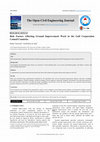
The Open Civil Engineering Journal, 2020
Aim: This research aims to identify the risk factors related to ground improvement projects in th... more Aim: This research aims to identify the risk factors related to ground improvement projects in the Gulf Corporation Council Countries (GCC). Background: Investigating and identifying those factors are essential to avoid schedule delay, cost overruns, diminished quality, and failure to achieve the project design requirements. Methods: A questionnaire was used to prioritize the possible risk factors that influence the ground improvement projects in the GCC. Results: Data were collected using a questionnaire completed by 120 respondents who work in the ground improvement industry in the GCC, including geotechnical engineers, technical managers, operation managers, project engineers, and project managers. Participants were asked three questions for each risk factor. Questions were about the impact, probability, and detection of the risk factor. Responses were analyzed using descriptive statistics, Responses' Score (R.S.), and Risk Priority Number (RPN). Conclusion: Five risk factors...
prediction from FWD results using artificial neural network
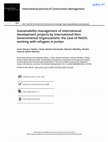
International Journal of Construction Management, 2020
Sustainability is one of the most significant challenges in International Development (ID) projec... more Sustainability is one of the most significant challenges in International Development (ID) projects. This research aims to study the role of Project Management (PM) tools in promoting the adoption of sustainability strategies in the ID projects by International Non-Governmental Organizations (INGOs). A quantitative approach was used to collect data through an online questionnaire completed by 84 respondents who occupy managerial positions in the ID projects in Jordan. The results of this study indicate a moderate adoption of PM tools and high adoption of sustainability strategies in ID projects in Jordan. The results also show all the PM tools are positively correlated with sustainability strategies, but only "Work breakdown structure" and "Risk analysis" positively affect the adoption of sustainability strategies. The study concludes that by increasing the investment in developing sustainability practices and PM knowledge for project managers, an increase in sustainability knowledge and a better sustainability performance might be achieved. With the lack of similar studies in the humanitarian field, this study tries to provide evidence for the relationship between PM and sustainability. KEYWORDS Project management tools; sustainability strategies; international development projects; INGOs; Jordan Research problem The two topics of "sustainability" and "project management" have been addressed separately in countless studies, however,
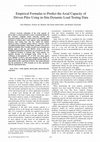
International Journal of Machine Learning and Computing, 2019
Accurate estimation of the axial capacity of driven piles is crucial and leads to more economical... more Accurate estimation of the axial capacity of driven piles is crucial and leads to more economical design. In this research, Artificial neural networks (ANNs) and regression analysis (RA) have been used to develop empirical formulas to estimate piles' axial capacity using experimental dynamic load testing data. The RA model was further improved using a nonlinear fitting software "Eureqa", based on artificial programming. Three input variables were used to build the formulas; these variables are pile cross-sectional area, friction angle at pile tip, and effective stress at pile tip. Simplified mathematical expressions are presented to be used as empirical formulas to estimate piles' axial capacity. An optimize formula was developed using ANNs; it has a coefficient of determination (R 2) of 0.92, root mean square error (RMSE) of 478.11, and mean absolute error (MAE) of 366.67. On the other hand, the improved RA formula has R2 of 0.86, RMSE of 450.1, and MAE of 416.91. The results indicated that the predictions of ANNs formula are in close agreement with the experimental data.
Journal of Performance of Constructed Facilities, 2018
AbstractUsing a mechanically stabilized earth (MSE) wall as a bridge abutment has become an attra... more AbstractUsing a mechanically stabilized earth (MSE) wall as a bridge abutment has become an attractive option to the traditional cast-in-place wall abutment. The use of an MSE wall abutment notably...
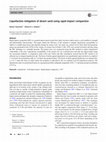
Arabian Journal of Geosciences, 2018
Rapid impact compaction (RIC) is a ground improvement system that, lately, has been widely used a... more Rapid impact compaction (RIC) is a ground improvement system that, lately, has been widely used as a soil modifier to strength and deformability characteristics. This paper studies the efficiency of this method to mitigate liquefaction susceptibility of shallow to middle-deep desert sand deposits during the strong event. The study was carried out by direct field measurements using cone penetration tests (CPTs) in the vicinity of a project site in Dubai, UAE. CPTs were carried out before and after using the RIC technique as a remedial measure. The project area was compacted using the RIC method to reduce liquefaction vulnerability of the area. Liquefaction susceptibility of the project site was evaluated prior and after the improvement using two assessment methods. A comparative study of the area, before and after remediation, showed that the RIC method is an efficient way to mitigate liquefaction risk. The factor of safety against liquefaction was significantly improved down to a depth of 3-4 m below the groundwater table (4-5 m below the ground surface). The factor of safety against liquefaction was enhanced by (1.2-to 7) times the factor of safety before the treatment as indicated by the two methods used for liquefaction analysis. The liquefaction study was performed based on a maximum possible earthquake magnitude of M = 7.5 and peak ground acceleration of 0.25 g.
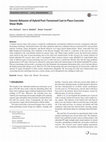
Arabian Journal for Science and Engineering, 2018
A hybrid concrete shear wall system is created by combining the conventional reinforced concrete ... more A hybrid concrete shear wall system is created by combining the conventional reinforced concrete construction with posttensioning technology. Such hybrid shear wall with continuous mild steel combined with post-tensioned (PT) steel provides superior restoring, energy dissipation, and ductile behavior over larger lateral displacements. Hence, both mild steel and high-strength post-tensioning steel contribute to the flexural strength. This leads to a reduction in the total area of steel when compared to the conventional reinforced concrete shear wall. When using a hybrid system, the lateral load response varies based on the ratio of post-tensioning steel to the mild steel reinforcement. In this research, the seismic behavior of hybrid unbonded PT concrete shear walls is investigated. Finite element analysis using ABAQUS for multi-hybrid shear walls of different ratios of post-tensioning steel area to mild steel area is performed. Results show that the large nonlinear displacements in PT shear wall may be reduced by using more mild steel reinforcement in the hybrid unbonded PT system. The post-tensioning steel provides a restoring force that eliminates the permanent deformation after cyclic load and reduces the displacement peaks during a cycle. However, PT walls incorporating only post-tensioning bars do not provide a sufficient amount of energy dissipation to limit seismic displacement adequately. By increasing the mild steel reinforcement area concerning the post-tensioning steel area, seismic energy can be dissipated by the yielding of mild steel.
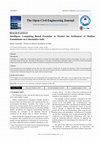
The Open Civil Engineering Journal, 2019
Introduction:Although it is a regular duty of geotechnical engineers to evaluate how much shallow... more Introduction:Although it is a regular duty of geotechnical engineers to evaluate how much shallow foundation settles in the granular soil, there is no well-approved formula for this task. The intent of this research is to develop a formula that is adequately simple to be used in routine geotechnical engineering work but complete enough to address the behavior of granular soil associated with the settlement issue.Methods:Cone penetration test and foundation load test data were used to generate a formula that can predict the settlement. Genetic Programming (GP) based Symbolic Regression (GP-SR) and artificial neural networks were used to develop an optimized formula. Settlements were also calculated using the finite method and compared to the results of the developed formula.Results and Conclusion:Two formulas were developed using SR, and several models were developed using ANN. ANN model 1 has the highest R2value (0.93) and the lowest MSE (0.16) among all developed ANN and GP-SR mode...

Proceedings of the Institution of Civil Engineers - Ground Improvement, 2019
Rapid impact compaction (RIC) has been used effectively as a ground improvement at medium depth t... more Rapid impact compaction (RIC) has been used effectively as a ground improvement at medium depth technique for granular soils. RIC is normally used to increase bearing capacity, reduce potential settlements and mitigate liquefaction. This paper presents a calibrated three-dimensional cap-plasticity finite-element model (FEM) to simulate ground improvement using RIC. The results of 107 RIC field compaction points were used to calibrate and validate the FEM. Numerical outcomes of the FEM showed good agreement with the field compaction results. The FEM was further used to propose a relationship between the soil bearing capacity and the number of hammer blows for engineering practice. This is attained by performing pushover analysis of a spread footing resting on RIC improved soils with different numbers of RIC blows. The RIC, circular 1·5 m anvil was used as the spread footing. The applied stresses that produced 25 mm settlement are considered the improved soil bearing capacity. Also, t...

Case Studies in Construction Materials, 2018
The Dynamic Replacement (DR) technique has been used successfully to improve soft soils. It uses ... more The Dynamic Replacement (DR) technique has been used successfully to improve soft soils. It uses the dynamic compaction energy to drive granular materials down into the soils, forming a pillar of 2 to 2.5m diameter. In this paper, a 30,000 m 2 study is used to evaluate the performance of the technique. Cone penetration tests (CPTs) were carried out before ground improvement to analyze the soil and select the appropriate technique. Post improvement CPTs (inside and between pillars) and load tests were carried out to confirm that the design requirements (bearing capacity and settlement) are met. It is proposed to use the Schmertmann [1] and Schmertmann et al. [2] method for calculating the settlements. However, to make it applicable to the case of DR for clayey soils, a methodology is proposed to calculate an equivalent tip resistance based on the DR replacement ratio. The values of the equivalent tip resistance are used to calculate the equivalent modulus of elasticity of the soil for settlement calculations. A finite element model has been built to simulate the revised formula, and the calculated settlements have shown a good agreement with the conducted measurements and the finite element model results as well.

Proceedings of the Institution of Civil Engineers - Geotechnical Engineering, 2017
Shallow foundation load tests were performed on desert sands. Previously, cone penetration tests ... more Shallow foundation load tests were performed on desert sands. Previously, cone penetration tests (CPT) and pressuremeter tests (PMT) had been done at each location to determine soil properties. Settlements were calculated from CPT and PMT data using common empirical methods. CPT data were employed to predict settlement behaviours utilising methods proposed by Schmertmann in 1970, Schmertmann and co-workers in 1978, Meyerhof in 1974 and DeBeer in 1965. PMT results were used to predict settlement behaviours using the method offered by Menard in 1975. Standard penetration test N60-values were estimated from CPT results using an artificial neural network model developed by Tarawneh in 2016. It is concluded that the method proposed by Menard in 1975 is reliable, as it over-predicted by an average ratio of 1·27. When using CPT data for settlement estimates, the methods of both Meyerhof and DeBeer over-predicted by an average ratio of 2·84 and 1·96, respectively, and that of Schmertmann by...
Journal of Pipeline Systems Engineering and Practice, 2017
AbstractCulverts have been used to transmit surface drainage under roadways in place of typical s... more AbstractCulverts have been used to transmit surface drainage under roadways in place of typical short-span bridges because they provide an economical construction system. In this paper, a numerical...

Proceedings of the Institution of Civil Engineers - Ground Improvement, 2017
Dynamic replacement (DR) and dynamic compaction (DC) have been used effectively as ground improve... more Dynamic replacement (DR) and dynamic compaction (DC) have been used effectively as ground improvement techniques to reduce settlement, increase bearing capacity and mitigate liquefaction. A case study of 11 million m2 of ground improvement work, using DC and DR, is presented to define lessons that can be learned. Before the ground improvement work, an extensive soil field testing campaign was completed, which revealed the heterogeneity of the soil strata: the type of soil encountered, its stiffness and the depth of the weak soil to be improved. A comprehensive analysis of the soil testing allowed the identification of the appropriate ground improvement techniques to meet the project schedule and achievement of the required bearing capacity and the permitted settlement. The results of the ground improvement work are discussed in this paper. Also, the lessons learned from the ground improvement work are presented.
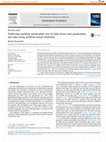
Geoscience Frontiers, 2017
Standard Penetration Test (SPT) and Cone Penetration Test (CPT) are the most frequently used fiel... more Standard Penetration Test (SPT) and Cone Penetration Test (CPT) are the most frequently used field tests to estimate soil parameters for geotechnical analysis and design. Numerous soil parameters are related to the SPT N-value. In contrast, CPT is becoming more popular for site investigation and geotechnical design. Correlation of CPT data with SPT N-value is very beneficial since most of the field parameters are related to SPT N-values. A back-propagation artificial neural network (ANN) model was developed to predict the N 60-value from CPT data. Data used in this study consisted of 109 CPT-SPT pairs for sand, sandy silt, and silty sand soils. The ANN model input variables are: CPT tip resistance (q c), effective vertical stress ðs 0 v Þ, and CPT sleeve friction (f s). A different set of SPT-CPT data was used to check the reliability of the developed ANN model. It was shown that ANN model either under-predicted the N 60-value by 7e16% or over-predicted it by 7e20%. It is concluded that back-propagation neural networks is a good tool to predict N 60-value from CPT data with acceptable accuracy.
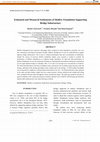
Shallow foundations have numerous advantages when compared to deep foundations; primarily: low co... more Shallow foundations have numerous advantages when compared to deep foundations; primarily: low cost, fast construction and being environment friendly. Shallow foundations on soils are underutilized to support highway bridge substructures. This is due to a limited performance data and overestimation of settlements. Despite the success of previous shallow foundation studies, more research is needed to evaluate the performance of shallow foundations as a highway bridge foundation. To study the field performance of shallow foundations on soil, the central pier footing was instrumented and monitored during the construction of a two-span highway bridge in Columbus, Ohio. A-2-4 and A-3a soil types were encountered in a borehole. The field instrumentations consisted of multiple sensors and stations for recording contact pressure under the footing, settlement of the footing and tilting of pier columns tied to the footing. A USGS quality benchmark was incorporated to establish a solid permane...
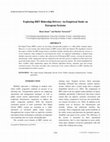
Bus Rapid Transit (BRT) systems are becoming internationally popular as a viable public transport... more Bus Rapid Transit (BRT) systems are becoming internationally popular as a viable public transport option. However, it is not exactly clear which features of BRT systems affect the demand. The hypothesis tested in this paper is whether the BRT design features contribute to higher ridership above and beyond any increase in service frequency when compared to conventional bus routes. An empirical methodology is adopted using multiple regression analysis to analyze data collected on 40 European BRT systems, covering the operation, infrastructure, traffic management and user demand for the selected systems, in addition to other factors like speed and design features. Two models were developed using regression analysis. The models highlighted the three variables which significantly impact the demand: population density, operation span and average commercial speed. The paper concludes with a discussion of the various influences on BRT ridership and recommendations for future research.
ABSTRACT Thesis (Ph.D.)--Ohio University, June, 2005. Includes bibliographical references (leaves... more ABSTRACT Thesis (Ph.D.)--Ohio University, June, 2005. Includes bibliographical references (leaves 182-185)
Sandra Mapel, P.E. (Traffic Engineer) James Roberts (Vice President) Disclaimer Statement: The co... more Sandra Mapel, P.E. (Traffic Engineer) James Roberts (Vice President) Disclaimer Statement: The contents of this report reflect the views of the authors who are responsible for the facts and accuracy of the data presented herein. The contents do not necessarily reflect the official views of the Ohio Department of Transportation or the Federal Highway Administration. This report does not constitute a standard, specification or regulation.











Uploads
Papers by Bashar Tarawneh